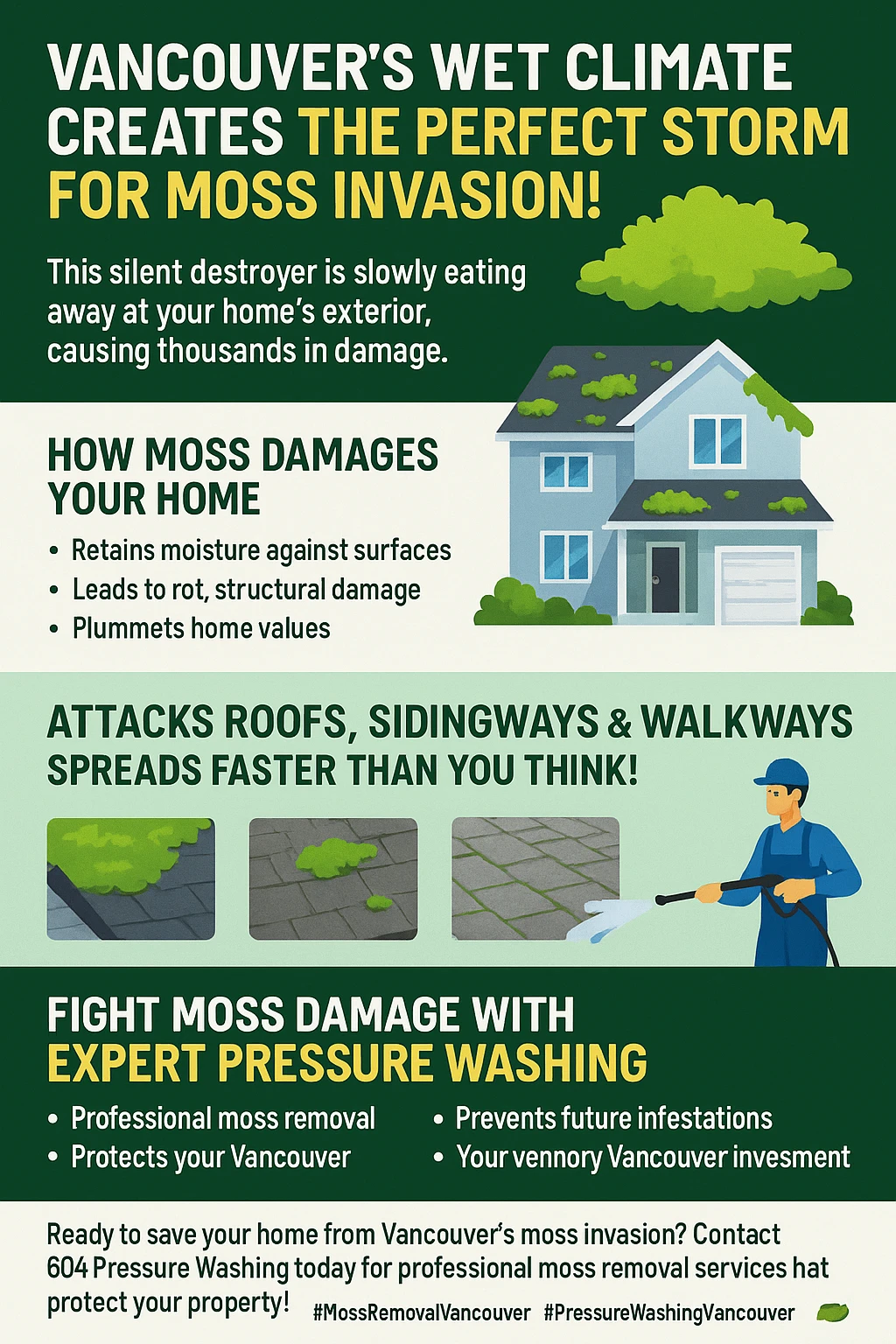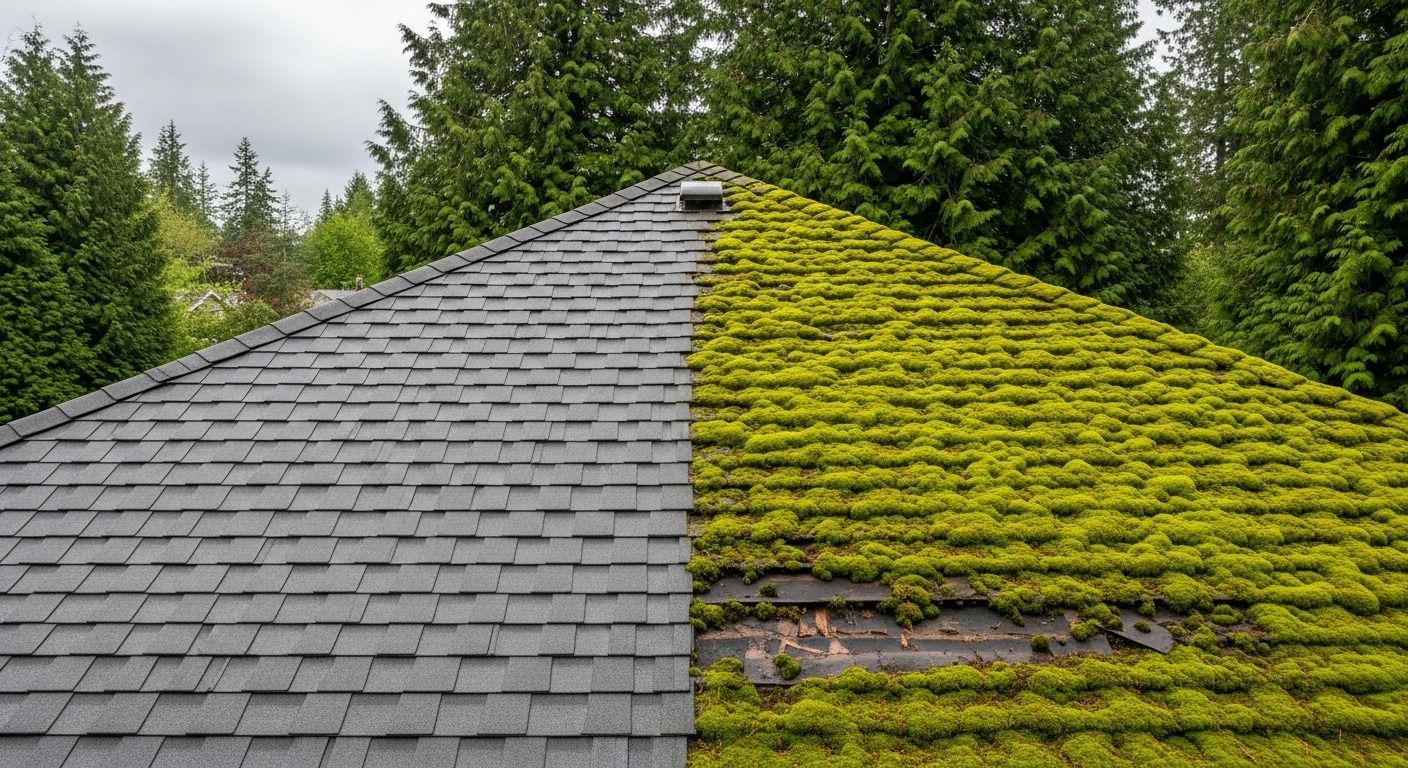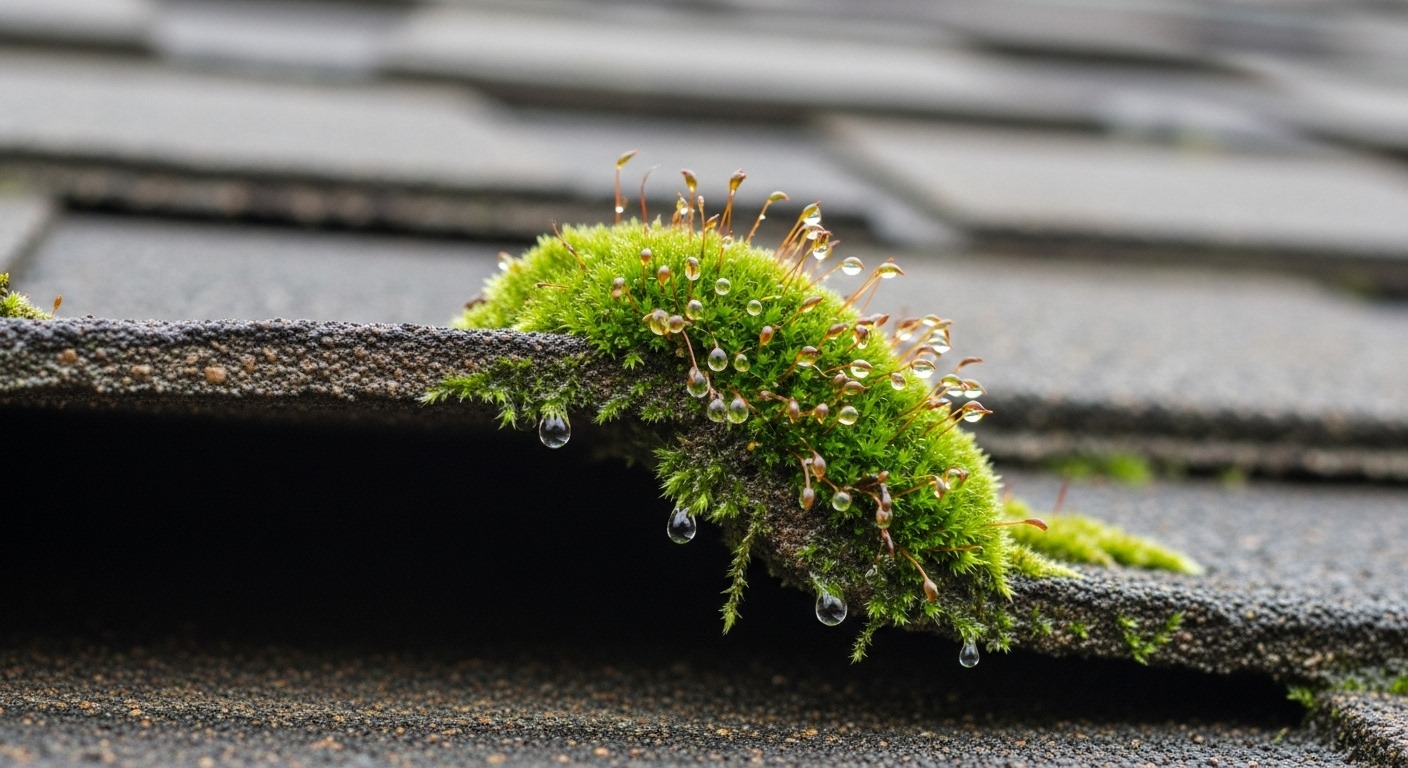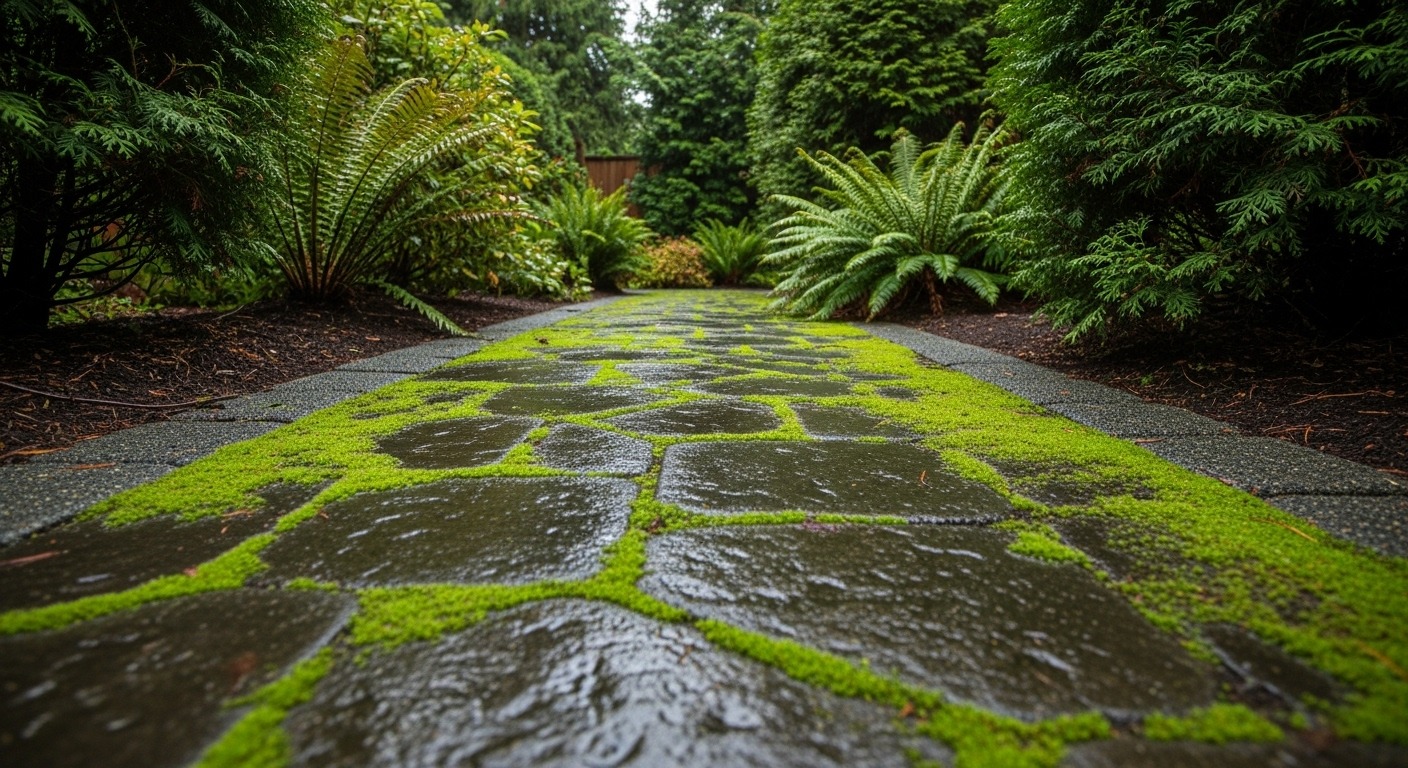Seeing green patches creeping across your Vancouver roof but aren’t sure if it’s worth addressing? That silent moss carpet might be quietly costing you thousands in structural damage while destroying your home’s curb appeal and safety.Picture this: you’re sipping your morning coffee, admiring Vancouver’s lush greenery through your window, when you notice something unsettling. That charming moss creeping across your neighbor’s roof isn’t just an aesthetic issue – it’s a ticking time bomb that’s literally eating their home alive. Here in Vancouver, where we get 169 rainy days per year and our temperate oceanic climate creates the perfect breeding ground for moss, this isn’t just a seasonal nuisance. It’s a year-round threat that’s silently destroying property values and structural integrity across the Lower Mainland. What makes Vancouver’s moss problem particularly insidious is how deceptively harmless it appears. That velvety green carpet might look quaint, even cottage-like, but underneath it’s creating a moisture trap that’s rotting away shingles, compromising structural supports, and turning your biggest investment into a money pit. The statistics are staggering: over 60% of coastal British Columbia homeowners have dealt with moss infestations, and many don’t realize the extent of the damage until it’s too late.
Key Takeaways:
- Moss can reduce your roof’s lifespan by 10-15 years, potentially costing homeowners up to $14,000 in premature roof replacement
- Over 60% of coastal British Columbia homeowners have dealt with moss infestations, making it a widespread regional problem that affects property values and insurance coverage
- Professional moss removal costs $500-$1,500 in BC but prevents far more expensive structural repairs and maintains your home’s warranty coverage
- Soft washing techniques are safer and more effective than high-pressure methods for roof moss removal, preserving shingle integrity while eliminating the problem
- Vancouver’s climate creates year-round moss growth conditions, requiring proactive prevention strategies rather than reactive cleanup

Vancouver’s Climate: The Perfect Storm for Moss Growth
 Understanding why Vancouver faces such a persistent moss problem starts with recognizing our unique weather patterns. Our city sits in USDA plant hardiness zone 8, which sounds technical but essentially means we have ideal conditions for moss growth nearly year-round. With 1,189mm of annual rainfall and those signature overcast skies that define our fall, winter, and spring months, we’re essentially living in a giant terrarium.The real kicker? Different neighborhoods face varying levels of risk. North Vancouver residents deal with a whopping 2,477mm of rain annually – more than double what folks near the airport experience. This creates microclimates across the region where some homes battle moss infestations while others just a few kilometers away might have minimal issues. The coastal influence, combined with our mild temperatures that rarely dip below freezing for extended periods, means moss doesn’t go dormant like it would in harsher climates.What’s particularly fascinating about Vancouver’s moss situation is the seasonal growth patterns. While many people assume moss is just a winter problem, it actually experiences growth surges in late fall and early spring when moisture levels peak and temperatures hover in that sweet spot between 5-15°C. During our infamous “drought” summers, moss doesn’t die off – it simply slows down and waits for the rains to return. This creates a cycle where homeowners think they’ve solved their moss problem during dry spells, only to watch it explode back to life with the first autumn rains.The diversity of moss species thriving in our zone 8 climate also sets Vancouver apart from other Canadian cities. We’re not just dealing with one type of moss; multiple species have adapted to different parts of our homes. Some prefer the consistent shade of north-facing roofs, while others thrive on the moisture-retaining surfaces of walkways and siding. This variety means a one-size-fits-all approach rarely works – you need targeted strategies for different areas of your property.
Understanding why Vancouver faces such a persistent moss problem starts with recognizing our unique weather patterns. Our city sits in USDA plant hardiness zone 8, which sounds technical but essentially means we have ideal conditions for moss growth nearly year-round. With 1,189mm of annual rainfall and those signature overcast skies that define our fall, winter, and spring months, we’re essentially living in a giant terrarium.The real kicker? Different neighborhoods face varying levels of risk. North Vancouver residents deal with a whopping 2,477mm of rain annually – more than double what folks near the airport experience. This creates microclimates across the region where some homes battle moss infestations while others just a few kilometers away might have minimal issues. The coastal influence, combined with our mild temperatures that rarely dip below freezing for extended periods, means moss doesn’t go dormant like it would in harsher climates.What’s particularly fascinating about Vancouver’s moss situation is the seasonal growth patterns. While many people assume moss is just a winter problem, it actually experiences growth surges in late fall and early spring when moisture levels peak and temperatures hover in that sweet spot between 5-15°C. During our infamous “drought” summers, moss doesn’t die off – it simply slows down and waits for the rains to return. This creates a cycle where homeowners think they’ve solved their moss problem during dry spells, only to watch it explode back to life with the first autumn rains.The diversity of moss species thriving in our zone 8 climate also sets Vancouver apart from other Canadian cities. We’re not just dealing with one type of moss; multiple species have adapted to different parts of our homes. Some prefer the consistent shade of north-facing roofs, while others thrive on the moisture-retaining surfaces of walkways and siding. This variety means a one-size-fits-all approach rarely works – you need targeted strategies for different areas of your property.
The Hidden Costs: How Moss Destroys Your Home’s Value and Structure
Let’s talk numbers, because the financial impact of ignoring moss goes far beyond what most homeowners realize. The most dramatic statistic I’ve encountered comes from a recent case where a BC homeowner avoided a $14,000 roof replacement by investing $2,500 in professional moss removal. That’s not an anomaly – it’s becoming increasingly common as insurance companies crack down on preventable maintenance issues.Here’s what happens when moss takes hold: it acts like a biological sponge system, trapping moisture against your roof materials and creating perfect conditions for rot, mold, and structural degradation. On asphalt shingles, this moisture seeps under the edges, lifting them slightly and allowing water to penetrate the underlayment. The granules that protect your shingles from UV damage get compromised, leading to premature aging and those telltale dark streaks that scream “neglected property” to potential buyers.  Wood shingles face an even grimmer fate. Vancouver’s consistently humid conditions mean that once moss creates those micro-environments of trapped moisture, wood rot can spread rapidly through shake shingles. I’ve seen roofs where homeowners thought they had a minor moss issue, only to discover that entire sections of decking had rotted away underneath.The ripple effect extends beyond just roofing materials. As moss retains moisture and that moisture works its way into structural supports, you’re looking at potential damage to rafters, trusses, and even interior walls if leaks develop. The average cost of roof repairs due to moss ranges from minor fixes costing $500 to full roof replacements exceeding $10,000. But here’s the real kicker – most insurance policies won’t cover moss-related damage because it’s considered preventable maintenance.Property values take a hit too. Real estate agents consistently report that homes with visible moss problems sell for 5-10% less than comparable properties, and many buyers simply walk away rather than deal with the perceived maintenance nightmare. In Vancouver’s competitive market, that could translate to tens of thousands in lost value, far exceeding the cost of professional moss removal.
Wood shingles face an even grimmer fate. Vancouver’s consistently humid conditions mean that once moss creates those micro-environments of trapped moisture, wood rot can spread rapidly through shake shingles. I’ve seen roofs where homeowners thought they had a minor moss issue, only to discover that entire sections of decking had rotted away underneath.The ripple effect extends beyond just roofing materials. As moss retains moisture and that moisture works its way into structural supports, you’re looking at potential damage to rafters, trusses, and even interior walls if leaks develop. The average cost of roof repairs due to moss ranges from minor fixes costing $500 to full roof replacements exceeding $10,000. But here’s the real kicker – most insurance policies won’t cover moss-related damage because it’s considered preventable maintenance.Property values take a hit too. Real estate agents consistently report that homes with visible moss problems sell for 5-10% less than comparable properties, and many buyers simply walk away rather than deal with the perceived maintenance nightmare. In Vancouver’s competitive market, that could translate to tens of thousands in lost value, far exceeding the cost of professional moss removal.
Beyond the Roof: Moss Attack on Siding, Walkways, and Outdoor Spaces
While roofs get most of the attention, moss’s assault on your home extends far beyond overhead. Your siding, particularly on north-facing walls where sunlight rarely penetrates, becomes a canvas for moss and algae growth that creates both aesthetic and structural challenges. The combination creates not just an unsightly appearance but genuine health concerns, especially for family members with respiratory sensitivities.What many homeowners don’t realize is that moss on siding isn’t just sitting on the a – it’s actively working its way into the material. On wood siding, moss creates moisture pockets that lead to rot and insect infestations. Even vinyl and fiber cement siding suffer damage as moss works into joints and seams, compromising weather seals and allowing moisture infiltration. The recommended treatment involves soft washing using low-pressure water combined with eco-friendly cleaning agents, but timing and technique are crucial to avoid driving contaminants deeper into the material.Walkways and outdoor spaces present their own set of challenges, particularly regarding safety. Moss-covered walkways become incredibly slippery, especially after Vancouver’s frequent rain showers. This creates serious liability issues for homeowners – if a delivery person, visitor, or even a family member slips and falls on moss-covered surfaces, you could be facing legal ramifications beyond just the repair costs. I’ve spoken with insurance adjusters who note an increasing number of slip-and-fall claims related to poorly maintained walkways and outdoor spaces.  Driveways and patios face a triple threat: moss, algae, and the accumulation of oil stains, bird droppings, and debris create surfaces that require specialized cleaning approaches. Standard pressure washing might seem like the obvious solution, but different materials require different techniques. Concrete can typically handle higher pressure, while natural stone and interlocking pavers need gentler methods to avoid damage or displacement.The interconnected nature of these problems means addressing moss in one area while ignoring others creates an ongoing cycle. Moss spores from untreated roofing can settle on walkways, while moisture from poorly maintained siding creates ideal conditions for moss growth on adjacent surfaces. A comprehensive approach addresses all these areas simultaneously, providing better long-term results and cost efficiency.
Driveways and patios face a triple threat: moss, algae, and the accumulation of oil stains, bird droppings, and debris create surfaces that require specialized cleaning approaches. Standard pressure washing might seem like the obvious solution, but different materials require different techniques. Concrete can typically handle higher pressure, while natural stone and interlocking pavers need gentler methods to avoid damage or displacement.The interconnected nature of these problems means addressing moss in one area while ignoring others creates an ongoing cycle. Moss spores from untreated roofing can settle on walkways, while moisture from poorly maintained siding creates ideal conditions for moss growth on adjacent surfaces. A comprehensive approach addresses all these areas simultaneously, providing better long-term results and cost efficiency.
Professional vs DIY: Why Pressure Washing Expertise Matters
The internet is full of DIY moss removal guides, and I get it – the appeal of saving money is strong. But here’s what those guides don’t tell you: improper moss removal can cause more damage than the moss itself. I’ve seen homeowners turn minor moss issues into major roofing disasters by using too much pressure, wrong chemical mixtures, or inappropriate timing.Professional pressure washing brings several key advantages that go beyond just having the right equipment.

